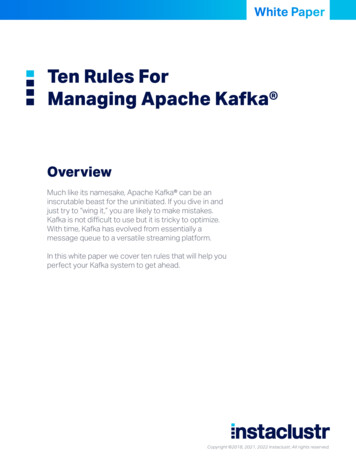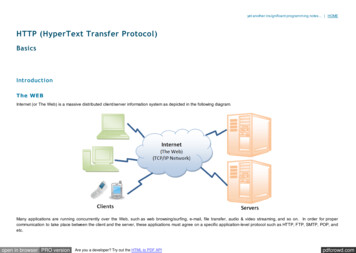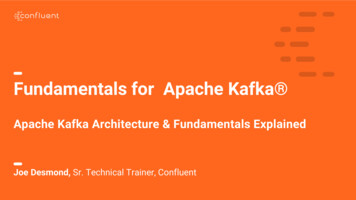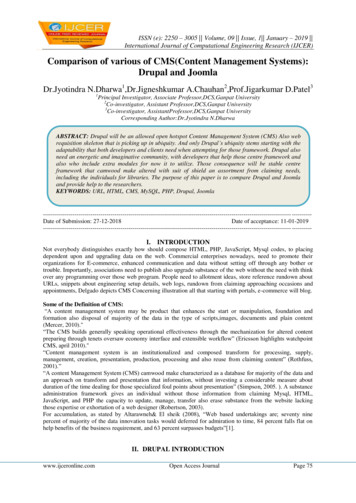
Transcription
White PaperTen Rules ForManaging Apache Kafka OverviewMuch like its namesake, Apache Kafka can be aninscrutable beast for the uninitiated. If you dive in andjust try to “wing it,” you are likely to make mistakes.Kafka is not difficult to use but it is tricky to optimize.With time, Kafka has evolved from essentially amessage queue to a versatile streaming platform.In this white paper we cover ten rules that will help youperfect your Kafka system to get ahead.Copyright 2018, 2021, 2022 Instaclustr, All rights reserved.
1. LogsKafka has a lot of log configurations. The defaults are generally sane but most users willhave at least a few things they will need to tweak for their particular use case. You need tothink about retention policy, cleanups, compaction, and compression.The three parameters to worry about are: log.segment.bytes, log.segment.ms, and log.cleanup.policy (or the equivalent settings at the topic level).If you don’t need to worry about preserving logs then you can set cleanup.policy to ‘delete’and let Kafka remove log files after a set time or after they reach a certain size. If you doneed to keep logs around for a while, use the ‘compact’ policy. The defaults are generallysane but if your use case is unique you may need to adjust the frequency of compactions.Remember that log cleanup isn’t free—it eats CPU and RAM every time it runs. If you arerelying on Kafka to serve as a kind semi-long-term commit log, be sure your compactionsrun frequently enough but do not harm performance.2. Hardware RequirementsWhen tech teams first start playing with Kafka there is a tendency to just sort of ‘ballpark’the hardware—just spin up a big server and hope it works. In actuality Kafka does notnecessarily need a ton of resources. It is designed for horizontal scaling thus you can getaway with using relatively cheap commodity hardware.Here some basic points to remember:CPU: Doesn’t need to be very powerful unless you’re using SSL and compressing logs. Themore cores, the better for parallelization. If you do need compression we recommend usingLZ4 codec for best performance in most cases.Memory: Kafka works best when it has at least 6 GB of memory for heap space. The restwill go to OS page cache which is key for client throughput. Kafka can run with less RAM,but don’t expect it to handle much load. For heavy production use cases go for at least32 GB.Disk: Because of Kafka’s sequential disk I/O paradigm SSD’s will not offer much benefit. Donot use NAS. Multiple drives in a RAID setup can work clustr2
Network and Filesystem: Use XFS and keep your cluster in a single data center if possible.The higher the network bandwidth the better.3. Apache ZooKeeper We could do an entire white paper just on ZooKeeper . It is a versatile piece of softwarethat works great for both service discovery and a range of distributed configuration usecases. For brevity’s sake, we’ll offer just three key points to keep in mind when setting it upfor Kafka. Avoid co-locating ZooKeeper in any major production environmentThis is a shortcut many companies take thanks to the spread of Docker. They figure theycan run Kafka and ZooKeeper as separate Docker containers on one instance by carefullylocking in memory and CPU limits. This is actually fine for a development environments oreven smaller production deployments assuming you take the right precautions. The riskwith larger systems is that you lose more of your infrastructure if a single server goes down.It’s also suboptimal for your security setup because Kafka and ZooKeeper are likely goingto have a very different set of clients and you will not be able to isolate them as well. Do not use more than five ZooKeeper nodes without a really greatreasonFor a dev environment, one node is fine. For your staging environment you should use thesame number of nodes as production. In general three ZooKeeper nodes will suffice fora typical Kafka cluster. If you have a very large Kafka deployment, it may be worth goingto five ZooKeeper nodes to improve latency, but be aware this will put more strain on thenodes. ZooKeeper tends to be bound by CPU and network throughput. It is rarely a goodidea to go to seven or more nodes as you will end up with a huge amount of load from allseven nodes trying to stay in sync and handle Kafka requests (not as much of an issue inthe later Kafka versions that rely less on ZooKeeper). Tune for minimal latencyUse servers with really good network bandwidth. Use appropriate disks and keep logs on aseparate disk. Isolate the ZooKeeper process and ensure that swap is disabled. Be sure totrack latency in your instrumentation @instaclustr3
4. Replication and RedundancyThere are a few dimensions to consider when thinking about redundancy with Kafka. Thefirst and most obvious is just the replication factor. We believe Kafka defaults at 2 butfor most production uses 3 is best. It will allow you to lose a broker and not freak out. If,improbably, a second broker also independently fails, your system is still running. Alongsidereplication factor you also have to think about datacenter racks zones. In AWS for example,you would not want to have your Kafka servers in different regions, but putting them indifferent availability zones is a good idea for sake of redundancy. Single AZ failures havehappened often enough in Amazon.5. Topic ConfigYour Kafka cluster’s performance will depend greatly on how you configure your topics. Ingeneral you want to treat topic configuration as immutable since making changes to thingslike partition count or replication factor can cause a lot of pain. If you find that you need tomake a major change to a topic, often the best solution is to just create a new one. Alwaystest new topics in a staging environment first.As mentioned above, start at 3 for replication factor. If you need to handle large messages,see if you can either break them up into ordered pieces (easy to do with partition keys)or just send pointers to the actual data (links to S3 for example). If you absolutely haveto handle larger messages be sure to enable compression on the producer’s side. Thedefault log segment size of 1 GB should be fine (if you are sending messages larger than1 GB, reconsider your use case). Partition count, possibly the most important setting, isaddressed in the next section.6. ParallelizationKafka is built for parallel processing. Partition count is set at the topic level. The morepartitions, the more throughput you can get through greater parallelization. The downsideis that it will lead to more replication latency, more painful rebalances, and more openfiles on your servers. Keep these tradeoffs in mind. The most accurate way to determineoptimal partition settings is to actually calculate desired throughput against your hardware.Assume a single partition on a single topic can handle 10 MB/s (producers can actuallyproduce faster than this but it’s a safe baseline) and then figure out what your desired totalthroughput is for your system.If you want to dive in and start testing faster, a good rule of thumb is to start with 1 partitionper broker per topic. If that works smoothly and you want more throughput, double lustr4
number, but try to keep the total number of partitions for a single topic on a single brokerbelow 10. So for example, if you have 24 partitions and three brokers, each broker willbe responsible for 8 partitions, which is generally fine. If you have dozens of topics anindividual broker could easily end up handling hundreds of partitions. If your cluster’s totalnumber of partitions is north of 10,000 then be sure you have really good monitoringbecause rebalances and outages could get really thorny.7. SecurityThere are two fronts in the war to secure a Kafka deployment: Kafka’s internal configuration, and The infrastructure on which Kafka is running.Starting with the latter, the first goal is isolating Kafka and ZooKeeper. ZooKeeper shouldnever be exposed to the public internet (except for unusual use cases). If you are only usingZooKeeper for Kafka, then only Kafka should be able to talk to it. Restrict your firewalls/security groups accordingly. Kafka should be isolated similarly. Ideally there is somemiddleware or load balancing layer between any clients connecting from the public internetand Kafka itself. Your brokers should reside within a single private network and by defaultreject all connections from outside.As for Kafka’s configuration, the .9 release added a number of useful features. Kafka nowsupports authentication between itself and clients as well as between itself and ZooKeeper.Kafka also now supports TLS, which we recommend using if you have clients connectingdirectly from the public internet. Be advised that using TLS will impact throughputperformance. If you can’t spare the CPU cycles then you will need to find some other way toisolate and secure traffic hitting your Kafka brokers.8. Open File ConfigUlimit configuration is one of those things that can sneak up on you with a lot of differentprograms. Devops engineers have all been there before. A Pagerduty alert fires late at night.Seems at first like a load issue but then you notice one or more of your brokers is just totallydown. You dig through some logs and get one of these: “java.io.IOException: Too manyopen files.”It’s an easy fix. Edit /etc/sysctl.conf with a larger value for max open files and restart. Saveyourself an outage and ensure that your deployment system (Chef, CloudFormation, etc.) issetting a hard Ulimit of at least staclustr5
9. Network LatencyThis one is pretty simple. Certainly low latency is going to be your goal with Kafka. Ideallyyou have your brokers geographically located near their clients. If your producers andconsumers are located in the United States, best not to have your Kafka brokers in Europe.Also be aware of network performance when choosing instance types with cloud providers.It may be worthwhile to go for the bigger servers with AWS that have greater bandwidth ifthat becomes your bottleneck.10. Monitoring (to catch all of the above)All of the above issues can be anticipated at the time of cluster creation. Howeverconditions change, and without a proper monitoring and alerting strategy, you can get bitby one of these problems down the road. With Kafka you want to prioritize two basic typesof monitoring: system metrics and JVM stats. For the former you need to ensure you trackopen file handles, network throughput, load, memory, and disk usage at a minimum. Forthe latter, be mindful of things like GC pauses and heap usage. Ideally you will keep a goodamount of history and set up dashboards for quickly debugging issues.For alerting, you will want to configure your system (Nagios, PagerDuty, etc.) to warn youabout system issues like low disk space or latency spikes. Better to get an annoying alertabout reaching 90% of your open file limit than getting an alert that your whole system hascrashed.ConclusionKafka is a powerful piece of software that can solve a lot of problems. Like most librariesand frameworks, you get out of it what you put into it. If you have a solid infrastructure anddev team that can devote sufficient time, you can do amazing things with Kafka. Lackingthat, Kafka can be risky. Fortunately there is a growing ecosystem of managed offerings.With the right provider you can get all of the performance and scaling benefits of Kafkawithout having to go it alone. To that end, check out Instaclustr’s newest offerings in theKafka space.Ready to Experience Instaclustr Managed Apache Kafka ?Reach out to our Sales team aclustr6
AboutInstaclustrInstaclustr helps organizations deliver applications at scale through its managed platform for opensource technologies such as Apache Cassandra , Apache Kafka , Apache Spark , Redis ,OpenSearch , PostgreSQL , and Cadence.Instaclustr combines a complete data infrastructure environment with hands-on technology expertiseto ensure ongoing performance and optimization. By removing the infrastructure complexity, weenable companies to focus internal development and operational resources on building cutting edgecustomer-facing applications at lower cost. Instaclustr customers include some of the largest andmost innovative Fortune 500 companies. 2021 Instaclustr Copyright Apache , Apache Cassandra , Apache Kafka , Apache Spark , and Apache ZooKeeper are trademarks of The Apache Software Foundation. Elasticsearch and Kibana are trademarks forElasticsearch BV. Kubernetes is a registered trademark of the Linux Foundation. OpenSearch is a registered trademark of Amazon Web Services. Postgres , PostgreSQL and the Slonik Logo are trademarks or registered trademarksof the PostgreSQL Community Association of Canada, and used with their permission. Redis is a trademark of Redis Labs Ltd. *Any rights therein are reserved to Redis Labs Ltd. Cadence is a trademark of Uber Technologies, Inc.Any use by Instaclustr Pty Limited is for referential purposes only and does not indicate any sponsorship, endorsement or affiliation between Redis and Instaclustr Pty Limited. All product and service names used in this website are foridentification purposes only and do not imply m@instaclustr7
Managing Apache Kafka Overview Much like its namesake, Apache Kafka can be an inscrutable beast for the uninitiated. If you dive in and just try to "wing it," you are likely to make mistakes. Kafka is not difficult to use but it is tricky to optimize. With time, Kafka has evolved from essentially a










